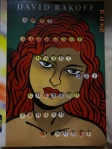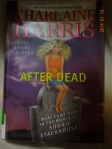Warner Library serves Tarrytown and Sleepy Hollow. There’s a big browsing section of new books added to the library collection.
 Title: The Ice-Cream Shop Detective
Title: The Ice-Cream Shop Detective
Author: Ronnie Levine
Publication Information: [No place given]: New Views Press, c2014
ISBN: 0692204482 (i.e. 978-0692204481)
Library of Congress Classification: PS3562.E8474
Library of Congress Subject Headings:
Franklin, Lissa (Fictitious character)—Fiction
Artists–New York (State)–Tarrytown—Fiction
Criminal investigation–New York (State)–Tarrytown—Fiction
Ice-cream parlors–New York (State)–Tarrytown—Fiction
Detectives–New York (State)–Tarrytown—Fiction
Love–Fiction
Ronnie Levine is a name I know. She’s a local artist who has had at least one installation at the Silver Tips Tea Room in Tarrytown. She has done paintings of downtown Tarrytown that are quite striking. Main Street Sweets, the family-owned ice-cream shop upon which Bellini’s is based, was in one of the paintings. That painting contained the buildings around the shop, and the sky was a breathtaking blue. I remember how beautiful I thought that blue was.
Lissa Franklin is also a local artist who enjoys the old masters, particularly the French Impressionists. She painted a mural in Bellini’s, and then is asked to add to it. (Main Street Sweets also has a mural which I believe Levine also painted.) Bellini’s is owned by Detective Nick Bellini, whose family owns the shop. (Detective Sargent Eugene Buonanno of the Tarrytown Police Department’s family owns Main Street Sweets.) The book begins with the Lissa discovering the body of an acquaintance who she knew from the local artists’ association. The book then backtracks to bring us up to date, and then continues on until the murders are resolved.
Lissa’s opinion of contemporary art was fascinating and informative. She not only doesn’t like it, she explains the idea behind it: expressing ideas or feelings in physical form. This form can be anything but what the French Impressionists and other artists from the past did, namely painted what they saw around them. I have no real interest in modern art, and this explanation came as a revelation.
The idea fits nicely into the story, as Lissa ends up being enlisted by Nick to help the Tarrytown Police crack a case that deals not only with murder but also with art forgeries, particularly those of Monet. Lissa loves Monet’s art, and has studied him and the other French Impressionists. As a result, she is able to tell by looking at a painting whether or not it is a forgery. In one dialog with an art critic, she discusses the idea behind modern art which, paradoxically, she points out that art forgeries should be considered contemporary, since the entire idea behind them is to mimic and copy something. With a laugh, he agrees. This would theoretically turn forgeries into acceptable modern art.
Lissa’s just had a past relationship that we learn little about, except she had been in it for several years and left after realizing that the man was no good. Nick’s ex-wife materializes after having run away to Europe to work with a world famous doctor that she met where she worked. We find all this out from Nick’s sister, who goes on to tell Lissa that Nick’s ex quickly became dissatisfied with her life and walked out on Nick, but not before having an abortion and not telling her husband beforehand that she was pregnant. The ex and Nick’s sister had been friends since childhood. She came back because she realized her mistake and wanted Nick.
And that’s it. We never see the ex again in the entire book. Occasionally she’s referred to; as far as we (and Lissa) can tell, Nick does not learn about the abortion. Whether or not the ex even talked to him is never revealed. However, Lissa’s attraction to Nick is not only evident, but his evident attraction to her ends with their pillow talk in the last scene of the book. No big surprise.
There were an awful lot of typos, too. I normally don’t pay much attention to typos, unless there are many, and this book has misspellings as well as words repeated or the wrong word used.
This is a first novel. However it is not evident if this is going to be a one-shot novel or if it is the first in a series.





